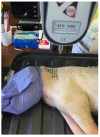The Effect of Needle Reuse on Piglet Skin Puncture Force
- PMID: 35202343
- PMCID: PMC8876719
- DOI: 10.3390/vetsci9020090
The Effect of Needle Reuse on Piglet Skin Puncture Force
Abstract
The study investigated whether the repeat use of needles used to inject piglets with iron, influences the force required to puncture into piglet cadaver skin. Pig units (n = 31) were surveyed on needle reuse and injection practices, and these findings informed subsequent laboratory-based experiments on needle puncture force into piglet cadaver tissues. A 21 G 5/8" needle was reported as the most used needle type (67.7%), with 80.6% reporting needle reuse; 38.7% changed the needle between litters or earlier if damaged, 16.1% every three litters and 22.5% when it felt blunt or damaged, after each injection session or when changing the bottle of iron solution. There was a significant difference in puncture force between the 1st and 36th use (p < 0.05), and between the 1st and 100th use (p = 0.0015), but not between the 1st and 12th or 36th use (p > 0.999 and p = 0.8313, respectively). Scanning electron microscopy (SEM) imaging showed appreciable damage to the needle tip after 12 uses. The repeat use of needles in piglet cadavers increased the force of needle puncture compared to first-time use. When extrapolated to live animals, the use of blunt needles has the potential to cause pain and distress.
Keywords: animal welfare; needle reuse; piglet skin; puncture force; scanning electron microscopy.
Conflict of interest statement
The authors declare no conflict of interest. The funders had no role in the design of the study, in the collection, analyses, or interpretation of the data; in the writing of the manuscript, or in the decision to publish the results.
Figures











Similar articles
-
Comparative Analysis of Taper Point and Reverse Cutting Needles on Skin Puncture Force.Dermatol Surg. 2025 Feb 1;51(2):144-147. doi: 10.1097/DSS.0000000000004401. Epub 2024 Sep 13. Dermatol Surg. 2025. PMID: 39268943
-
[Precise application of Traditional Chinese Medicine in minimally-invasive techniques].Zhongguo Gu Shang. 2018 Jun 25;31(6):493-496. doi: 10.3969/j.issn.1003-0034.2018.06.001. Zhongguo Gu Shang. 2018. PMID: 29945400 Chinese.
-
Microscopic analysis of three different spinal needle tips after experimental subarachnoid puncture.Reg Anesth Pain Med. 2000 Mar-Apr;25(2):163-9. doi: 10.1053/rapm.2000.0250163. Reg Anesth Pain Med. 2000. PMID: 10746529
-
The effect of relative needle diameter in puncture and sham injection animal models of degeneration.Spine (Phila Pa 1976). 2008 Mar 15;33(6):588-96. doi: 10.1097/BRS.0b013e318166e0a2. Spine (Phila Pa 1976). 2008. PMID: 18344851 Review.
-
The association between post-dural puncture headache and needle type during spinal anaesthesia: a systematic review and network meta-analysis.Anaesthesia. 2021 Aug;76(8):1098-1110. doi: 10.1111/anae.15320. Epub 2020 Dec 17. Anaesthesia. 2021. PMID: 33332606
Cited by
-
Needle-free intradermal vaccination, an opportunity to improve commercial pig welfare.Anim Welf. 2024 Nov 4;33:e48. doi: 10.1017/awf.2024.53. eCollection 2024. Anim Welf. 2024. PMID: 39703218 Free PMC article.
-
The Evaluation of a Porcine Circovirus Type 2 (PCV2) Intradermal Vaccine Against a PCV2 Field Strain.Vaccines (Basel). 2025 Mar 24;13(4):343. doi: 10.3390/vaccines13040343. Vaccines (Basel). 2025. PMID: 40333212 Free PMC article.
-
Assessing Reuse of Hypodermic Needles in Mice by means of Digital Imaging, Photomicrography, Bacterial Culture, Analysis of Nest Building, and Animal Vocalization.J Am Assoc Lab Anim Sci. 2023 May 1;62(3):205-211. doi: 10.30802/AALAS-JAALAS-22-000094. Epub 2023 Mar 29. J Am Assoc Lab Anim Sci. 2023. PMID: 36990673 Free PMC article.
-
Field Evaluation of a Ready-to-Use Porcine Circovirus Type 2 and Mycoplasma hyopneumoniae Vaccine in Naturally Infected Farms in Taiwan.Vet Sci. 2025 Mar 26;12(4):304. doi: 10.3390/vetsci12040304. Vet Sci. 2025. PMID: 40284806 Free PMC article.
-
Effect of Maternal Flavour Conditioning Combined with Organic and Inorganic Iron-Supplemented Creep Feed on Piglet Performance and Haemoglobin Status.Animals (Basel). 2024 Apr 23;14(9):1263. doi: 10.3390/ani14091263. Animals (Basel). 2024. PMID: 38731271 Free PMC article.
References
-
- AHDB UK Pig Numbers and Holdings. [(accessed on 9 September 2021)]. Available online: https://ahdb.org.uk/pork/uk-pig-numbers-and-holdings.
-
- AHDB GB Estimated Pig Slaughterings. [(accessed on 9 September 2021)]. Available online: https://ahdb.org.uk/pork/gb-estimated-pig-slaughterings.
-
- Gov.UK FAWC Report on the Welfare of Pigs Kept Outdoors. [(accessed on 9 September 2021)]; Available online: https://www.gov.uk/government/publications/fawc-report-on-the-welfare-of....
-
- Svoboda M.V., Berlinska J. Parenteral iron administration in suckling piglets—A review. Acta Vet. Brno. 2017;86:249–261. doi: 10.2754/avb201786030249. - DOI
Grants and funding
LinkOut - more resources
Full Text Sources

